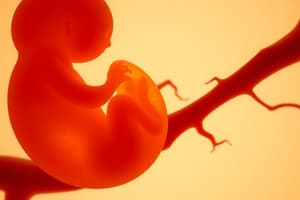Podcast
Questions and Answers
What is the primary function of the notochord in embryonic development?
What is the primary function of the notochord in embryonic development?
- Basis for the axial skeleton (correct)
- Development of the paraxial mesoderm
- Formation of the neural tube
- Formation of the primitive streak
Which of the following is NOT a derivative of the neuroectoderm?
Which of the following is NOT a derivative of the neuroectoderm?
- Sclerotome (correct)
- C cells of thyroid
- Ganglia
- Melanocytes
What is the name of the stage present on day 7/8 of embryonic development?
What is the name of the stage present on day 7/8 of embryonic development?
- Embryoblast
- Trophoblast
- Blastocyst (correct)
- Gastrulation
What is the result of the migration of epiblast cells towards the primitive streak?
What is the result of the migration of epiblast cells towards the primitive streak?
What is the term for the rounded structures in the head region that develop from the paraxial mesoderm?
What is the term for the rounded structures in the head region that develop from the paraxial mesoderm?
What is the name of the layer that forms between the hypoblast and the newly-produced endoderm?
What is the name of the layer that forms between the hypoblast and the newly-produced endoderm?
What is the term for the part of the nervous system that develops from the neuroectoderm?
What is the term for the part of the nervous system that develops from the neuroectoderm?
When does the primitive streak formation typically occur?
When does the primitive streak formation typically occur?
Flashcards are hidden until you start studying
Study Notes
Gastrulation Overview
- Gastrulation is the formation of three germ layers in the embryo: ectoderm, mesoderm, and endoderm.
- It begins with the formation of the trilaminar disc and marks the start of the development of somites and the neural tube.
Key Terms
- Trophoblast is composed of cytotrophoblast and syncytiotrophoblast.
- Embryoblast is composed of epiblast and hypoblast (by day 8).
- Blastocyst is the stage present on day 7/8.
Primitive Streak Formation
- The primitive streak appears at the beginning of the third week.
- A primitive groove forms along the longitudinal midline of the epiblast.
Cell Migration and Germ Layer Formation
- The formation of the primitive streak begins.
- Epiblast cells migrate towards the primitive streak.
- Some cells displace the hypoblast, forming the embryonic endoderm.
- Others form the mesoderm (mesenchyme) between the hypoblast and newly-produced endoderm.
- The epiblast is renamed ectoderm.
Formation of Notochord and Mesoderm
- Notochord is the basis for the axial skeleton, formed by cells from the primitive node.
- Types of mesoderm include paraxial mesoderm, intermediate mesoderm, and lateral plate mesoderm.
Development of Paraxial Mesoderm
- Paraxial mesoderm develops into somitomers and somites.
- Somitomers are rounded structures in the head region.
- The first somites appear on day 9.
- Somites establish the body's segmental organization.
Germ Layers: Origin and Tissue Development
Ectodermal Derivatives
- Neuroectoderm derivatives include melanocytes, Merkel cells, medulla of adrenal gland, C cells of thyroid, ganglia, and parts of the nervous system.
- Neural Tube derivatives include olfactory epithelium, cornea, epidermis, and its derivatives, hypophysis (adenohypophysis), enamel organ, lens, parotid gland, and epithelium of inner ear.
Mesodermal Derivatives
- Paraxial mesoderm derivatives include sclerotome, myotome, and dermatome.
- Sclerotome produces mesenchyme, which forms bone, cartilage, blood, adipose tissue, spleen, smooth muscles, and endothelium.
- Myotome forms skeletal muscles.
- Dermatome forms dermis.
- Intermediate mesoderm develops into parts of the urinary system and reproductive system.
- Lateral mesoderm forms visceral and parietal layers of the intra-embryonic body cavity, cardiac muscles, and cortex of the adrenal glands.
Endodermal Derivatives
- Urinary and reproductive structures include urinary bladder, urethra, prostate gland, bulbourethral glands, and vestibule of the vagina.
- Digestive and respiratory epithelium derivatives include gall bladder, respiratory tract, and digestive tract epithelium.
- Glandular structures derivatives include thyroid and parathyroid gland, liver and pancreas, thymus, and submandibular and sublingual glands.
- Additional epithelial structures derivatives include epithelium of the tympanic cavity and Eustachian tube.
Studying That Suits You
Use AI to generate personalized quizzes and flashcards to suit your learning preferences.




